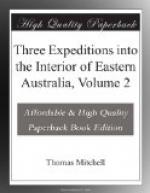MY RIDE TO MOUNT HOPE.
June 28.
The morning being fine I at length proceeded towards the hill which we had already twice seen from great distances. It bore 206 degrees 45 minutes (from North) and was exactly ten miles from our camp. After riding six miles through box-forest we crossed a dry creek, and immediately entered upon an extensive plain beyond which I had the satisfaction of seeing the hopeful hill straight before me.
This hill consisted of immense blocks of common granite composed of white felspar and quartz and black mica; and it appeared to form the western extremity of a low range. It was indeed a welcome sight to us all after traversing for several months so much flat country; and to me it was particularly interesting for, from its summit, I expected to obtain an extensive view over the unknown region between us and the southern coast. I accordingly named the hill Mount Hope.
WHITE ANGUILLARIA.
On the verdant plain near its foot we found a beautiful white anguillaria, a flower we had not seen elsewhere and which, notwithstanding the season, was in full bloom and had a pleasing perfume. It might indeed be called the Australian snowdrop for its hardy little blossom seemed quite insensible to the frost.
VIEW FROM MOUNT HOPE.
On reaching the summit of Mount Hope I saw various higher hills extending from south-south-west to west-south-west at a distance of about 35 miles. They were not all quite connected, and I supposed them to be only the northern extremities of some higher ranges still more remote. I perceived along their base a line of lofty trees, but it was most apparent on the horizon to the westward of the heights. The intervening country consisted, as far as the glass enabled me to examine it, of open grassy plains, beautifully variegated with serpentine lines of wood. In all other directions the horizon was unbroken and, as the trees of the Murray vanished at a point bearing 143 1/2 degrees from North on the border of a very extensive plain, I concluded that an important change took place there in the course of that river or the Goulburn (of Hovell and Hume); for it was uncertain then which river we were near. The granitic range of Mount Hope terminates in the plains, one or two bare rocks only projecting above ground on the flats westward of the hill. On its summit we found some plants quite new to us and, among the rocks on its sides, a species of anguillaria different from that on the plains, being larger in the stem and having a dark brown ring within the chalice, the edge of the leaves being tinged with the same colour.* We found here again the Baeckea micrantha seen on the 24th instant, also a remarkable new species of Eriostemon forming a scrubby spiny bush, with much the appearance of a Leptospermum,** and a new and very beautiful species of Pleurandra, with the aspect of the yellow Cistus of the Algarves.*** A remarkable hill of granite appeared 5 1/3 miles from Mount Hope, bearing 30 degrees 10 minutes West of South. It is a triangular pyramid and, being quite isolated, it closely resembles the monuments of Egypt.




